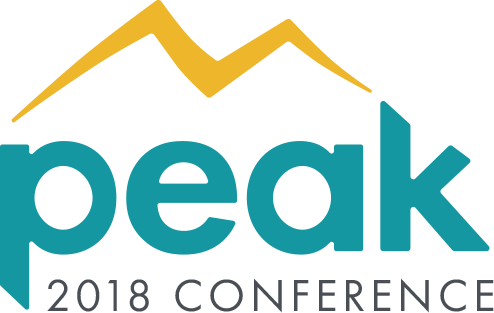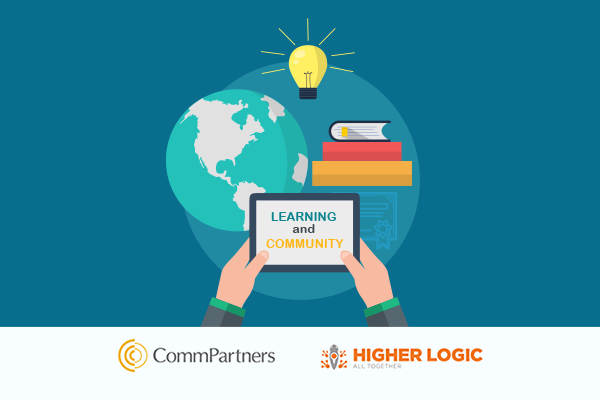
by Rich Finstein | Nov 13, 2017 | Blog
At the 2017 Higher Logic Super Forum, I along with an association colleague, facilitated a session on the virtues of developing an integrated approach for bringing together online community engagement and an LMS in a single offering. During the session, we discussed how associations typically have these areas configured as unique components. In reality, both provide opportunities for learning. Since an online community engagement strategy is usually focused on facilitating peer collaboration, and the learning management system (LMS) provides expert content, it’s natural they come together to support the stakeholder experience in a synergistic way.
A key connector in this relationship are live online events and webinars. Traditionally, live events and webinars have been positioned on their own through a registration and authentication page provided by the webinar vendor or a separate catalog of programs. A better, more engaging approach is to promote and provide access to these events within a private community.
Here are 5 considerations for using live, online events and webcasts to increase the impact of your online community engagement strategy:
- Registration will feel like a continuum of existing collaboration. Participants who have already been invested in the topic can now be encouraged, in an intuitive way, to take the step to register and participate in online discussions.
- Participation from new and non-engaged members is encouraged with an integrated approach. Live, online events and webinars are tangible ways to draw participants to specific areas of your Web presence. Offering them through a dedicated part of your LMS gives users a reason to create a profile and begin to participate in other social learning and online community engagement opportunities.
- Leverage interaction before and after an online event or webcast. Participants should be able to see who is attending, exchange ideas, and engage the presenters before the event. Afterward, users can continue any conversations that may have been cut short (which happens often!) during an hour program.
- Integrate results from live event and webinar attendance with other participation metrics, providing a complete picture of online community engagement. Host organizations will appreciate having a central repository to evaluate participation outcomes.
- Award badges or ribbons for participation or achievement from webinars in the same area where recognition is provided for other activities. Providing recognition will further encourage participation in future live, online events.
We see webinars and live events becoming much more collaborative and transparent. Bringing them into your online community is a natural way to build participation and provide synergy with your other educational objectives.
If you have interest in learning more about integrating events and webinars with your community contact us online, or email Meghan Gowen at mgowen@commpartners.com.

by Aubrey Mellos | Nov 1, 2017 | News
Columbia, MD – November 1, 2017. CommPartners, a leading provider of Learning Management Software, webinar, webcast, and livestream solutions announced details for Peak 2018 Conference. The event will take place March 15-16, 2018 in Washington, D.C.
Peak is a conference designed to inspire, educate, and train association professionals in a wide range of e-learning topics. The event will feature two keynote sessions, eight breakout sessions, deep-dive Elevate LMS trainings, peer knowledge exchanges, and more. Topics include Social Learning, Building a Dynamic LMS, Credentialing, Course Design, and e-Learning Trends. A complete agenda can be found at www.commpartners.com/Peak.
“We are excited to host our first conference where association peers can come together and not only receive extensive training on Elevate Learning Management System and our other services, but to also learn from peers who share similar challenges.” Richard Finstein, CEO, CommPartners
Learning opportunities and trainings will provide value to all professionals who have a key role in their organizations education and professional development strategy. Attendees will be eligible for up to 4 CAE credits and will also have the opportunity to connect socially with peers, partners, and industry leaders during a happy hour reception.
“It is our goal that attendees leave Peak 2018 with clear direction on how to revolutionize their online learning programs and to arm them with the tools to help them get there”, explains Finstein.
Peak 2018 – CommPartners’ First Education & User Conference
March 15-16, 2018
District Architecture Center | Washington D.C.
www.commpartners.com/peak
About CommPartners
CommPartners is a leading provider of online education and event solutions. At the core of the company’s solutions is our Elevate Learning Management System. Elevate is the only LMS with fully integrated and embedded webinar, livestream and multimedia software to support learning, how and when it occurs. The connection between live, peer-to-peer knowledge exchanges and traditional continuing education programs leads to improved learning outcomes, as well as increased participation within an organization’s education offerings. To learn more visit: www.commpartners.com

by Aubrey Mellos | Oct 18, 2017 | Blog
When considering how to monetize your learning, it is important to have a clearly defined and executed business strategy that properly aligns with your Learning Management System. Organizations often think of the LMS as simply the container and delivery site for their online programs. While this is true, if a goal is to make these programs profitable, it’s important to articulate and execute a revenue-generating online learning management strategy.
Here are six considerations to help ensure your e-learning programs are profitable:
Six Tips to Make Your Online e-Learning Program Profitable
1. Build a Knowledge Community vs. a Catalog of Opportunities
The LMS has evolved from a quiet presence within an organization’s website to a full-blown knowledge community that supports and integrates live and on-demand content in many forms. Be sure to incorporate social learning and peer to peer exchanges within your online e-learning platform to increase traffic and build a true knowledge community.
2. Provide Meaningful, Diversified and Relevant Content
Think of your LMS as an online learning store. Having an interesting array of content, create complementary offerings that range from free to high priced, high value. Attractively display your online content to satisfy a wider range of stakeholders’ needs and budgets.
3. Offer Individual Subscriptions & Pre-Payment
No one likes to take out their credit card and make a payment. Have your community pre-commit for access to your entire online e-learning platform, or a portion of this content through a subscription or package of programs. Make subscription purchases financially attractive.
4. Support Group Purchasing or Group Subscriptions
The easiest way to increase users of your online e-learning platform is to have all employees of an organization have access to your content. Engaging a single purchaser for many participants is a nice way to supplement individual purchases.
5. Integrate Online Learning with Other Organization Initiatives
Create loyalty by extending LMS discounts or assigning a pre-paid balance for online learning opportunities as a reward for investment in an organization. This could include a membership renewal or participating in an onsite conference.
6. Have an Attractive and Simple Shopping Cart Experience
Ensure your process for selection and payment of online learning is simple and intuitive. If you are integrating with an external database or AMS for purchases, make sure there is no visual or programmatic disconnect between the two programs.
Like any business, it takes an entrepreneurial approach to generate the returns you are hoping to receive. Investing time in the right online learning platform and having a successful strategy will help ensure a successful ROI.
Contact Us About Your e-Learning Needs
Whether you are considering investing in an LMS or simply looking to expand your organization’s e-learning strategy, CommPartners can help you create quality educational experiences that engage and inspire the learner. Fill out our online contact form or give us a call at (800) 274-9390 to learn how we can help.

by Rich Finstein | Sep 25, 2017 | Blog
It has been almost a year since CommPartners and Higher Logic began formally collaborating with the premise that learning in its many forms is a natural extension of community engagement. This concept is not new for most of us. I remember many conversations that took place at ASAE Annual Conferences and other meetings over the years about the virtues of social learning. Everyone agreed that the notion of peer to peer, sharing of ideas should accompany and be integrated with knowledge shared by experts. After all, when we think of the best learning experiences, it’s typically a conference with our community peers. We value the sessions but a significant part of our reason for attending is the knowledge we receive from colleagues. So why is online learning experiences so segmented?
While in theory this sounded like a wise idea, the execution of social learning was slow to take hold. There are likely many reasons for this, but the lack of an online platform that truly enabled Web based social experiences was not helping to forge the way.
Last year, Higher Logic and CommPartners’ teams got together to identify how we could make community driven learning a reality. We had certain ideas and it took quite an investment of time to identify how this could work. Our first success was the creation of Higher Logic’s Online Academy courses. This training enables participants to sign up and participate in a self-paced training program (powered through our learning management system, Elevate LMS) within the community. Completion of courses is reported to Higher Logic’s activities area, giving the community member and the host organization, in this case Higher Logic, a more holistic report of engagement that was taking place.
After this initial success, our efforts turned towards helping associations realize the benefits of bridging their Learning Management System and community to offer their stakeholders an integrated experience. As the discussions evolved, one question became clear; why are we asking our participants to navigate to two separate and distinct areas of a website when both areas provide opportunities for learning? Shouldn’t the synergy between these two components be together? So we went to work and came up with a fully integrated platform both visually and programmatically.
Key elements of Higher Logic’s community and CommPartners Elevate Learning Management System now work together, prioritizing the participant experience. Twelve months later we have many organizations that have embraced this integrated approach and we have certainly learned a lot. Here are four key lessons learned from bridging these two areas:
1. In many cases organizations still need a strong, independent learning presence. In these cases we have integrated the two platforms on a micro level. Examples include pulling in community participants that are enrolled in a course or webinar or reporting learning results to the activities area in the community. These are steps that more subtly bring the two together.
2. It’s important to have staff from both your education and community teams involved. There are many variations of community driven learning that can take place. Getting initial buy-in will ensure a smooth process and better result.
3. Opportunities for social learning extend beyond typical webinars or training. A program such as a virtual conference hosted through the LMS has the power to be integrated with a conference community leveraging the engagement already in place.
4. Working together allows us to provide better guidance to our clients. It’s been extremely valuable for the Higher Logic and CommPartners teams to work closely together to bridge the knowledge gap and provide better ideas and insights to our clients.
We’re excited about continuing to bridge the gap between community and learning. If you have an interest in integrating peer to peer idea sharing with traditional learning contact a representative from either Higher Logic or CommPartners to learn more.
VIEW ON-DEMAND WEBINAR
Learning & Community: Together at Last – Register

by Aubrey Mellos | Sep 20, 2017 | Blog
By Mary Byers, CAE, CSP
According to Forbes contributor Mike Maddock, “In order to make a product or service everything it can be, it needs to be repeatedly soft launched with both internal stakeholders and external customers. This means literally sending the idea—be it a product or a service—into a limited part of the marketplace with the full understanding that it will be modified (perhaps extensively) based on how customers and consumers react.”
But this isn’t how most associations approach innovation. Most I’ve worked with see innovation as a beginning and an end rather than an iterative process. A beginning and an end is more comfortable because we start and finish. We’re able to cross something off the list—and then we move on. It’s less comfortable to be “in process” with a fluctuating launch date (especially when reporting to a board of directors) and uncertainty about what the final product or service will look like.
Maddock’s iterative approach can be summed up in one word: experimentation. And it’s a strategy I’m suggesting for associations, albeit an uncomfortable one.
Certainty is much easier to sell, both internally and externally. But innovation can be anything but certain. Often, it’s a messy, chaotic process. And who likes that?
Though we may not like it, achievers and innovators have found a way to live with the messiness of experimenting. Even more so, they’ve adopted a willingness to experiment as a strategy for moving their associations forward. There’s a lot to be experimenting with these days in the association arena:
- Hybrid dues models
- Product pricing and packaging
- Online & e-learning
- Face-to-face meeting innovations
- Video vs. printed communications
- Governance
Experimenting in the above areas is difficult because there’s so much at stake. But there’s even more at stake for associations that don’t experiment. Declining revenue, decreasing meeting attendance, and falling membership numbers are just the beginning. There’s also loss of influence and long-term sustainability to consider.
There are three things that making experimenting easier for associations:
- Do it regularly. A culture of continuous experimentation not only helps determine where you can gain momentum, it becomes an expectation. And when it is an expectation, it’s easier to get your board and staff to support you.
- Utilize soft launches. There’s a lot at stake with a big, splashy roll-out. Start with small, quiet experiments. The bigger the project, the more important this is.
- Make recalibration a habit. Moddock writes, “We’re only right when the market tells us so….The market will help us see and hear what we can do to be more right (and also help us eliminate all the things our customers—and potential customers—don’t like or don’t want).”
The willingness to experiment is both a habit and a mindset. It’s also a valuable strategy for associations in today’s rapidly changing landscape.
Mary Byers, CAE, CSP, shares additional strategy starters for busy association professionals in her new online learning series titled, Momentum: Strategy Starters for Today’s Association Professional at leadwiselearning.com. She is also the author of Race for Relevance: 5 Radical Changes for Associations.






